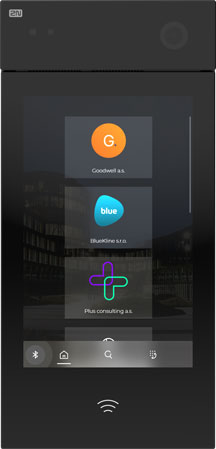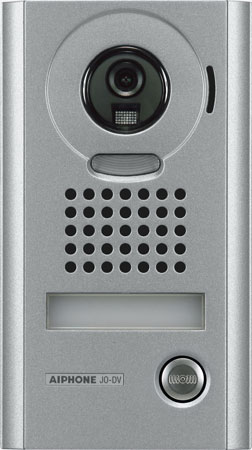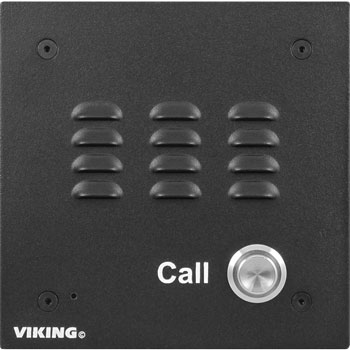Entry phones are vital communications devices that don’t get much air time.
What is an entry phone? We’re using the term “entry phone” to refer to intercoms that are used at doorways, gateways, and similar locations to allow safe and secure entry. They often have a connected door strike, which can unlock the entryway.
There are many types of entry phones, including VoIP and analog options. They might be as simple as a stainless-steel intercom with a single button that calls a single extension to a modular intercom with integrated HD camera, RFID reader, and keypad with stored credentials and more.
Both VoIP entry phones and analog entry phones are used extensively for different reasons.
In this blog, we clearly explain the benefits of both VoIP entry phones and analog entry phones.
Let’s get started!

What are the benefits of VoIP entry phones?
Why should you use VoIP entry phones?
VoIP entry phones are connected via the IP network to a central control platform, which is known as a VoIP phone system or IP PBX, and which can be either cloud-based or on-premise. For more on VoIP phone systems, check out our clear, detailed VoIP Phone Systems Buyer’s Guide.
VoIP entry phone systems are modern, feature-rich, and much, much more scalable.
VoIP platforms centralize system management, because you can manage every endpoint on the system from a single, secure user interface, which will be either software-based or browser-based. You can adjust settings, change what extensions are called, modify credentials, and so on from the UI. With many systems, you’ll be able to integrate your entry phones with your other communications endpoints like telephones and paging speakers, so you get a single unified communications solution, rather than needing to worry about multiple systems.
They’re much more scalable than traditional entry phone systems, which rely on hardwired connections. VoIP entry phones connect to the central platform via standard network connectivity, either Ethernet cables or Wi-Fi. Adding more entry phones is like adding another computer to your IP network (although you need to ensure you have the proper licenses to cover all your entry phones). Because they’re network-connected, you can have all your entry phones across multiple campuses — even across the country — on a single, secure network.
VoIP entry phones offer more options for secure entry. You still get standard duplex communications with buttons to call extensions or enter codes. But you’ll be able to find options that support Bluetooth for use with door entry apps on Android or iOS smartphones, RFID readers for use with RFID cards or key fobs hanging on lanyards, QR code scanners that scan QR codes that you send to visitors to simplify their experience, and more.
If you want to have a video entry phone so you can see who’s trying to enter, there will be IP video entry phones that offer better video resolution than traditional analog options. It’s common to see video intercoms with 1080p Full HD resolution.
Many VoIP paging systems will let you incorporate entry phones into emergency notification systems, so an intercom’s speaker will play an emergency alert in critical times.
In many cases, you can power the entry phone via POE (Power Over Ethernet). POE is a well-established standard for delivering power to a device through the same Ethernet cable that connects it to the network. Power is delivered via a POE network switch or POE injector/midspan. The advantage of POE is that you don’t need to worry about a separate power supply.
While VoIP entry phones have many positive qualities, there are benefits to using analog entry phones instead.

What are the benefits of analog entry phones?
Why should you use analog entry phones?
Analog entry phones are connected by dedicated cabling to a central control station, which is most often a PBX. You can think of them as the intercom equivalent of a traditional telephone.
You might have a dedicated telephone line for the entry phone. However, as we all know, traditional copper lines are going the way of the dodo, so this is potentially a reason to upgrade to VoIP. You also have to pay for that dedicated copper line, which is getting more and more expensive.
Which is annoying, because the primary benefit of analog entry phones is easy to understand: price. Analog intercoms are, in general, quite a bit less expensive than comparable VoIP units. Essentially, VoIP entry phones are little computers while analog entry phones aren’t.
Analog models can also be simpler to set up, particularly with small-scale installations like for a home where you can might go with a point-to-point solution: outdoor entry phone to indoor master station. And if you don’t want to worry about MAC addresses, firmware updates, and so on, an analog entry phone system is your answer.
Many entry phones are line-powered, which means they get their power via the telephone line to connects them to the PBX or dedicated POTS line. However, if the entry phone can’t be line-powered, you’ll need to use a separate power supply or electrical line. While POE power for VoIP entry phones runs over Ethernet cable that can be installed by a low-level technician, dedicated electrical lines need an electrician to install, which can add a lot of money to installation costs. Something to keep in mind.
Before the past couple decades, essentially all intercoms were analog, so many entry phone systems are still analog. If your system is already analog, you might want to just continue using the endpoints you already have. But if you also want to modernize your system, what do you do?
A hybrid system is your answer.

What about hybrid systems?
Hybrid intercom systems combine both analog and VoIP endpoints into a single system. Typically, a hybrid system would be structured like this: analog entry phones are connected to a VoIP phone system via IP paging adapters or VoIP gateways or an analog port on a VoIP phone system.
If you already have analog entry phones and you want to extend their lifetime while gaining the benefits of VoIP and modernizing your communications system, hybrid solutions let you bring existing devices into a VoIP system. You can manage the endpoints via the network.

